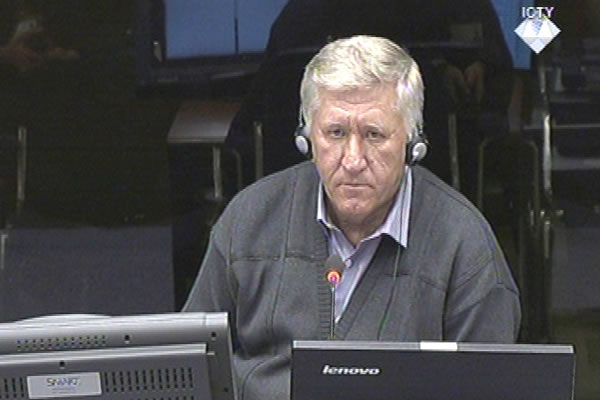Home
THOSE WHO KILLED CIVILIANS PUNISHED BY RETURNING TO THEIR UNITS
Mladic’s defense witness Branko Predojevic claims that in Sanski Most the Bosnian Serb Army was under strict orders to protect civilians and prisoners of war. The prosecutor tenders into evidence a series of documents showing that soldiers in the witness's unit, 6th Sana Brigade, and indeed in the battalion under his command, committed mass killings of Muslim and Croat civilians
 Branko Predojevic, defence witness at Rako Mladic trial
Branko Predojevic, defence witness at Rako Mladic trial In his testimony in Ratko Mladic's defense, war-time commander of the 3rd Battalion in the 6th Sana Brigade Branko Predojevic tried to absolve the Bosnian Serb Army of the blame for the crimes in Sanski Most and the area around it. The witness claimed that his unit had been under strict orders to treat prisoners of war ‘in line with the laws and customs of war’. No orders were directed against the non-Serb civilians, Predojevic argued.
The witness explained that any instances of unlawful treatment on the part of Serb soldiers were strictly punished. The defense tendered into evidence a criminal report filed in December 1992 against several soldiers in Predojevic’s brigade. At least one of them served in the 3rd Battalion. The case involved several members of the Gvozden family who were suspected of killing seven Croat civilians, including three women, in the village of Sasina near Sanski Most.
When the presiding judge asked if the perpetrators had been convicted, Predojevic replied that he didn’t know the outcome of the trial. What Predojevic did know was that soon after their arrest the perpetrators were released and returned to their unit. It was usual to allow soldiers who had committed crimes to return to their units and then to prosecute them after the war. ‘Sending them to the front line was a harsher sentence than letting them remain in prison’, the witness explained.
In the cross-examination, prosecutor Edward Jeremy presented documents from the Banja Luka military court. According to the documents, in their interview with the investigative judge the accused men stated they ‘want to return to the unit". They "suggested to the court to release them from detention’. The motion was granted in record time.Another document that shows that by 1999, long after the end of the war, the accused had not yet stood trial, was also admitted into evidence, as was a combat report from the 1st Krajina Corps, dated 6 December 1992, in which Mladic’s Main Staff is informed about the crime against Croats in Sasina.
The prosecutor noted that the members of the Gvozden family were not the only war criminals fighting in the witness’s battalion in the 6th Sana Brigade. Two of Predojevic’s soldiers took part in the mass murder on the Vrhpolje Bridge on 31 May 1992. The perpetrators – Zeljko Ilic and Jadranko Palija – forced a group of Muslims from several villages near Sanski Most to jump into the river and then fired shots at them. The witness didn’t deny that during the war Ilic and Palija had served in his unit. Predojevic claimed he didn’t know the details of the crime because he arrived in Sanski Most some 20 days later. The prosecutor reminded him that Jadranko Palija was sentenced to 28 years in prison for the Vrhpolje Bridge crime before the State Court in Sarajevo.
In his statement to the defense team Predojevic said that the Bosnian Serb army wasn’t involved in the expulsions of non-Serbs from Sanski Most. Also, according to Predojevic, the jurisdiction of the local Crisis Staff and the army in Sanski Most didn’t overlap. However, in the cross-examination the witness admitted that he actually didn’t know much about that because he had spent most of the war on the frontlines outside of the town.
Mladic’s defense continues its case tomorrow.
Linked Reports
- Case : Mladic
- 2015-01-27 MLADIC ‘SENSITIVE’ TO SUFFERING OF CIVILIANS
- 2015-01-26 AUTHENTICITY OF INTERCEPTED CONVERSATIONS CONTESTED
- 2015-01-23 GENERAL MLADIC’S ‘FLOWER GARDEN’
- 2015-01-29 AUTONOMOUS REGION OF BIRAC: DID IT PROTECT SERB INTERESTS ONLY?
- 2015-02-02 CIVILIANS STRONGER THAN ARMY
- 2015-02-03 CROATS HAD TO PAY THEIR WAY THROUGH SERB TERRITORY
